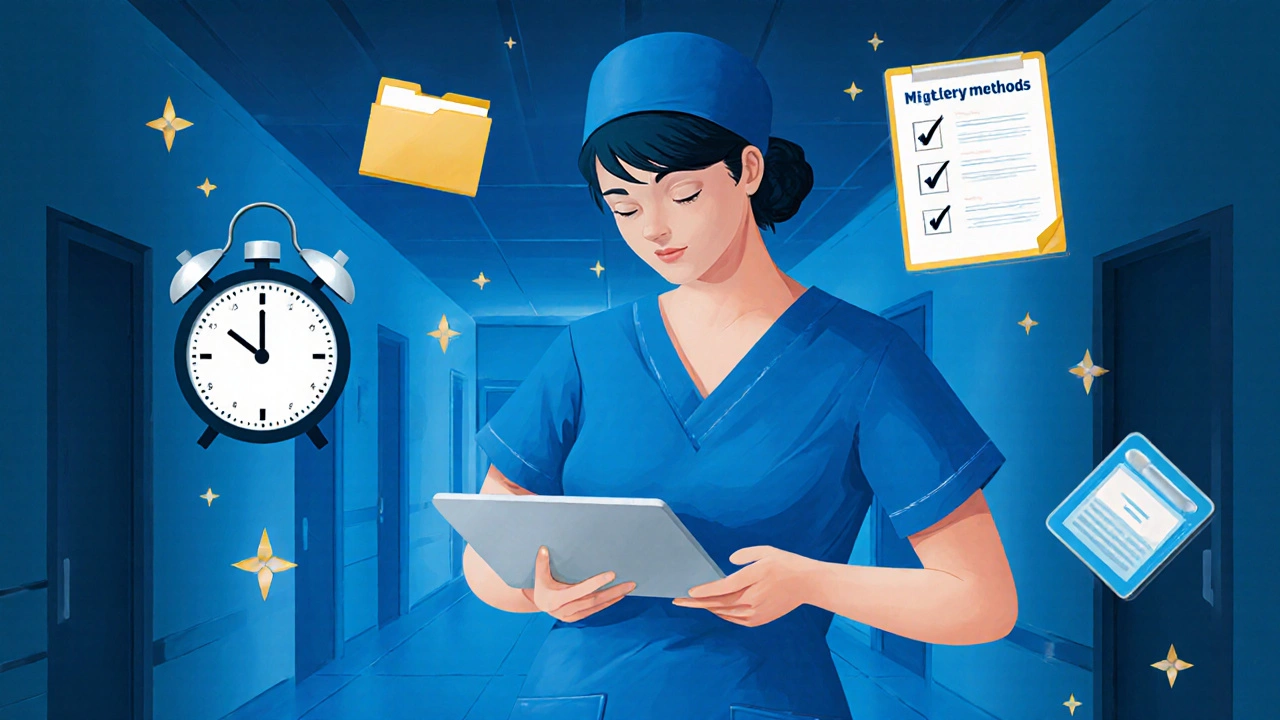Adult Learning Impact Calculator
How the Four Pillars Impact Learning
How immediately applicable is this learning to your real-world situation?
How much control do you have over your learning pace and path?
How well does the learning build on what you already know?
How much real-world application does this learning include?
Your Learning Impact Score
Based on your inputs, your learning effectiveness could improve by:
Actionable Recommendations
Applying just one more pillar could boost your learning effectiveness by 25%. Focus on:
- Make your learning more immediately applicable to solve your specific problem
- Give yourself more control over how you learn
- Build on your existing experience
- Practice in real-world contexts
Adults don’t learn like kids. That’s not a judgment-it’s biology, experience, and life context combined. If you’ve ever tried to teach an adult something new-whether it’s using a smartphone, switching to a new software system, or going back to school-you know it doesn’t work by just repeating the same methods used in high school. Adult learners bring decades of baggage: past failures, deep-seated beliefs, time constraints, and real-world stakes. So what actually works? Four practices stand out as the true pillars of adult learning, backed by decades of research and real-world success.
1. Relevance Is Non-Negotiable
Adults don’t learn for the sake of learning. They learn because they need to solve a problem, get ahead, or fix something broken. If the material doesn’t connect to their life right now, they tune out. A 45-year-old parent trying to learn budgeting won’t care about abstract economic theories. But show them how to cut $200 off their monthly expenses using a simple spreadsheet template-and suddenly, they’re engaged.
Studies from the Center for Adult Learning show that 78% of adult learners disengage when content feels theoretical or disconnected from their daily responsibilities. The key isn’t just making it relevant-it’s making it immediately applicable. When teaching adults, start with the problem they’re facing, not the theory behind it. Ask: What will they do differently tomorrow after this lesson?
Real-world example: A warehouse supervisor learning inventory software didn’t care about the software’s architecture. But when she saw how the system could cut her weekly stocktakes from four hours to 45 minutes, she became the first to master it-and trained her whole team.
2. Autonomy Builds Ownership
Adults hate being told what to do. They’ve spent years making their own decisions-at work, at home, in their relationships. When learning feels like a top-down mandate, resistance kicks in. But when they control the pace, path, and timing, motivation skyrockets.
That’s why self-paced online courses outperform scheduled lectures for adult learners. It’s not about convenience-it’s about control. A nurse studying for her certification might choose to review modules during her night shift breaks. A veteran returning to college might take one class per semester to balance family and work. Neither option is ‘ideal’ by traditional standards-but both are sustainable because the learner owns the rhythm.
Research from the University of Pennsylvania found that adult learners who could choose their own learning goals were 3.2 times more likely to complete their programs. Give adults choices: which topic to tackle first, how to demonstrate mastery (a project? a presentation? a written reflection?), and when to take breaks. Autonomy isn’t a perk-it’s the engine of retention.
3. Experience Is the Starting Point, Not the Obstacle
Many educators treat adult learners as blank slates. They’re not. Every adult comes in with a rich history of successes, failures, and hard-won wisdom. Ignoring that is like trying to teach someone to drive without letting them mention the car they’ve been driving for 20 years.
Effective adult learning starts by tapping into what learners already know. Ask: What have you tried before? What worked? What didn’t? Use their past experiences as a foundation. A former mechanic learning to code doesn’t need to start with ‘Hello World.’ He needs to see how debugging code is like diagnosing a faulty fuel injector-pattern recognition, trial and error, incremental fixes.
And when mistakes happen? That’s not failure-it’s data. Adult learners respect instructors who acknowledge their own past missteps. A teacher who says, ‘I tried this method last year and it bombed-here’s what I learned,’ builds instant trust. Experience isn’t something to overcome; it’s the raw material adult learning is built on.

4. Practice in Real Contexts Drives Mastery
Adults don’t learn by memorizing definitions. They learn by doing-and doing in situations that mirror real life. A salesperson won’t become better at negotiation by reading a textbook. They’ll improve by role-playing with a colleague, recording their pitch, and getting feedback from a customer.
This is called experiential learning, and it’s the most powerful tool for adults. The key is authenticity. Simulations, case studies, and on-the-job tasks work far better than quizzes or multiple-choice tests. A firefighter training for emergency response doesn’t memorize procedures-they run drills in smoke-filled rooms. A manager learning conflict resolution doesn’t watch a video-they mediate a real team dispute with coaching support.
According to the National Center for Education Statistics, adult learners who engaged in hands-on practice were 67% more likely to retain skills six months later than those who only attended lectures. The magic isn’t in repetition-it’s in context. If you want adults to remember something, make them use it. Immediately. In a way that feels real.
Putting It All Together
These four pillars aren’t optional extras. They’re the core structure of any effective adult learning experience. Skip one, and the whole system wobbles.
Think of it like building a house. Relevance is the foundation-you can’t build on sand. Autonomy is the frame-it holds everything together. Experience is the bricks-you use what’s already there. Practice is the roof-it protects the whole structure from falling apart.
Organizations that get this right see dramatic results. A hospital that redesigned its staff training around these four pillars saw a 52% drop in errors within six months. A tech company that replaced mandatory compliance videos with real-world scenarios saw completion rates jump from 31% to 89%.
It’s not about making learning easier. It’s about making it meaningful.

What Adult Learning Isn’t
It’s not cramming facts into someone’s head before a test. It’s not forcing people to sit through hour-long Zoom lectures they can’t focus on. It’s not pretending everyone learns the same way.
Adult learning is messy. It happens in between meetings, during lunch breaks, late at night after kids are asleep. It’s not perfect. But when it’s done right-when it respects the learner’s time, experience, and goals-it sticks.
Stop treating adult learners like students. Start treating them like adults.
Why don’t adult learners respond to traditional classroom methods?
Traditional classrooms assume learners are empty vessels waiting to be filled. Adults aren’t empty-they’re full of experience, responsibilities, and skepticism. They need to see the ‘why’ before they invest time. Lectures, rote memorization, and one-size-fits-all pacing ignore their life context. That’s why they tune out. Adult learning works when it’s practical, self-directed, and rooted in real problems they care about.
Can these four practices be used in online learning?
Absolutely-and they’re even more critical online. Without face-to-face pressure, adult learners need even clearer relevance, more control over pacing, and stronger real-world applications. Good online courses use case studies, interactive simulations, peer feedback, and self-assessment tools to mirror real-life challenges. The key is designing for autonomy and application, not just delivering content.
How do I know if my training program is working for adults?
Look beyond completion rates. Ask: Are learners applying what they learned? Are they solving problems they couldn’t before? Are they teaching others? If they’re still using the same old methods after training, the program didn’t stick. Track behavioral change-not test scores. A 2024 study in the Journal of Workplace Learning found that programs measuring real-world application saw 3x higher long-term retention than those tracking only quiz results.
Is there a best age to start adult learning?
No. Neuroplasticity-the brain’s ability to rewire itself-doesn’t shut down at 25 or 40 or 60. What changes is motivation and access. Older adults may have more barriers-time, energy, tech confidence-but they also bring deeper focus and clearer goals. The key isn’t age; it’s whether the learning experience respects their context. A 70-year-old learning to use video calls to connect with grandchildren learns faster than a 25-year-old forced to take a mandatory compliance course.
What’s the biggest mistake organizations make with adult training?
Treating it like a checkbox. Too many companies roll out training because HR says it’s required-not because it solves a real problem. They pick the cheapest platform, dump in generic content, and call it done. Adults see through that. The real cost isn’t the license fee-it’s the lost time, morale, and productivity when training fails to change behavior. Effective adult learning isn’t an expense. It’s an investment in human capability.
Next Steps for Learners and Educators
If you’re an adult learner: Before signing up for any course, ask three questions. Does this connect to something I need right now? Can I control when and how I learn it? Will I get to practice this in a real situation? If the answer to any is no, walk away.
If you’re designing training: Stop creating content. Start designing experiences. Map out the real tasks your learners need to do. Build practice into every module. Let them choose their path. Use their stories as examples. And never, ever assume they’ll care about something just because it’s important to you.
Adult learning isn’t about delivering information. It’s about unlocking potential. And it only works when you treat the learner like the expert they already are.






